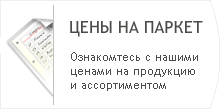Laying the parquet paneling
The parquet paneling is laid on the rough floor. The rough floor has to be stacked with the dry piney planks, the width of which must be no less than 40 mm, and the humidity — no more than 10%. The rough floor has to be stacked according to the level, after the effective fastening it has to be thoroughly planed and not to have deflections and nicks.
It is strongly recommended that laying the parquet paneling has to begin with the center of the building. Every panel fastens to the floor with the help of screws or building nails the length of which are 70 mm. The panels with grooves connect with each other by means of loose tongues of the hard wood. In the panel gaps, which have quarters, the added panels are inserted.
The humidity of the building, where the parquet is being laid, must be no more than 60%, and the temperature — no less than +16°C and no more than +22°C.
Parquet floor finishing
Having laid and fastened the parquet paneling, the floor is polished with the help of floor-polisher machines. Before grinding, separate burrs are polished.
To plane the parquet paneling by means of shaving machine is categorically forbidden! This may bring to the chips and burrages and as the result to the irremediable defects of the parquet floor.
Polishing carries out for three or four passes and every next pass is implemented at right angle to the previous. The polishing sandpaper is used on the tissue base according to the ÃÎÑÒó 5009-68. The polishing begins with the granular sandpaper #80, and the granular sandpapers #60 and #35 are used for the next passes. The remaining floor dust is moved off by means of vacuum cleaner. Three layers of lacquer are applied on the dry refined floor with the help of brush. The time period between every lacquer application is equal to 24 hours. You can exploit the floor in 48 hours when the varnishing is over.
Guidelines for the exploitation
During the exploitation (when the parquet floors covered with floor-polishes are dirtied) the floors must be washed with the special cleaners for the parquet floors. Having washed, the floors are polished with the acrid floor-polishes.
It is forbidden to wash the decorated parquet with the gasoline, acetone, and white spirit and with another caustic solution!
Using caustic solutions can bring to the dissolving the synthetic glue and to the spoiling the decorated parquet. Lacquer covering of the parquet floors is repaired every 3-4 years, depending on the intensity of the lacquer deterioration. Either all the surface is repaired, or separate deteriorated places. It is polished with the sandpaper and after dust-removal, it is varnished again. The varnished and rubbed floors, during everyday treatment, are cleaned from the dust with the help of damp mop, brush or vacuum cleaner. It is not allowed to spill large quantity of water on the floor. This may bring to the parquet swelling, and after moving off the moisture — to its crackness. Life time of the parquet depends upon keeping to the constant temperature and humidity conditions of the building during all the year. The humidity of the air in the building must exceed 60%, and temperature must hold within the limits of +10°C +25°C. Careful regular treatment and timely repair of the lacquer covering prolongs the life time of the parquet planks and keeps its initial look for a long time. Keeping all given instructions, the floor of the decorated parquet paneling, made in Kivertsy woodworking enterprise, will serve more than 50 years.
Security measures
- Electrical equipment of the polishing machines and other electric tools, used to parquet and polish the parquet paneling, have to be earthed.
- In the period of varnishing the parquet and drying the lacquer covering, it is forbidden to use the open flame and to execute the works in process of which the sparkles can arise.
- The building, where there is the parquet varnishing, is to be taken an airing thoroughly.
- Workers, fulfilling the finishing works with lacquers, which send off harmful fumes, have to be protected with respirators and gas-masks.

